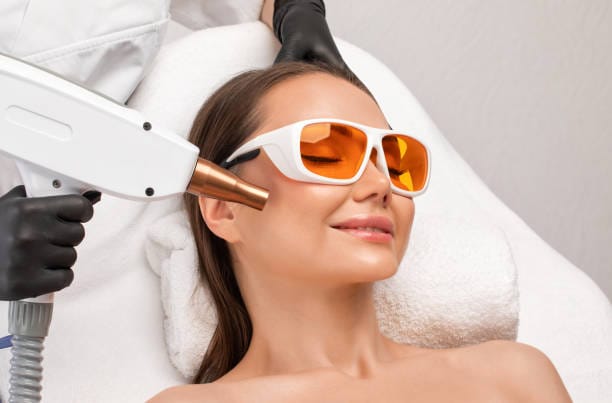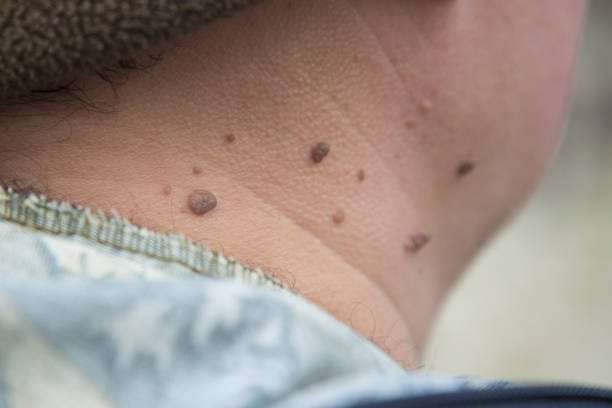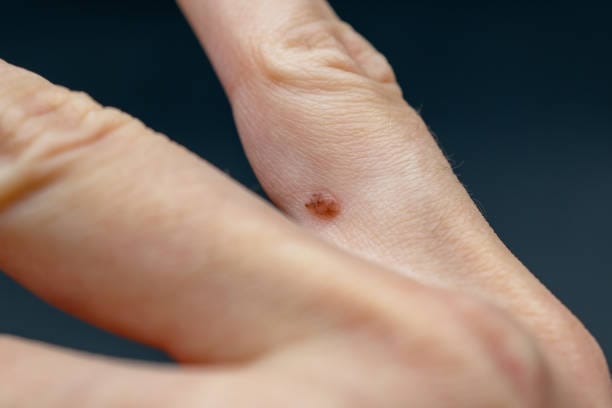
Moles are skin growths that are very common and may develop anywhere on the human skin. Although most moles are not dangerous, some give people a reason to go for mole removal either for cosmetic purposes or medical reasons. Moles are not the same size, they may be different in shape and color and some of them may change and cause skin malignancies such as melanoma.
In this article, we help you get familiar with: how to select the best mole removal treatment for the skin, the types of treatments, the characteristics of the skin, the characteristics of the mole, and the role of consulting with a specialist.
It is important to know the various types of mole removal treatments to get the best outcome from laser mole removal to Treatments excision. You might have come across these treatments but how do you get the best out of it?
Best Mole Removal Treatment With Different Methods of Getting Rid of Moles
There are many types of mole removal treatments; each of them has its different aspects for use depending on the kind of mole, its location, and the patient’s skin type. This is important because it will help you to decide which treatment would be most effective for you. Let’s explore the most common mole removal treatments available today:
1. Laser Mole Removal
Laser mole removal is one of the most popular options for the removal of moles without Procedure. This technique is to direct high-intensity light on the pigment within the mole to disintegrate it and then the body will eliminate it. It is especially useful for the treatment of flat, benign growths and is chosen for its accuracy and cosmetic results.
Why Laser Mole Removal is Recommended
Non-Invasive: No incisions or stitches needed, reduction of the chances of getting scars.
Minimal Downtime: It is very rare for a patient to have to take more than a day or two off work to recover from the procedure.
Precision: The laser only acts on the mole and has no impact on the other parts of the skin.
Fast Healing: The majority of patients regain their normal health soon after the treatment with little or no pain
There are many reasons why laser treatments are suitable for most people, including the fact that they are fast and give immediate results with little to no downtime. However, it cannot be effective for a large or deep mole that may require Treatments removal.
2. Treatments Excision
Excision is the most common technique of removing a mole and is commonly used for raised large or deep moles. During this procedure, the mole is excised and the skin around it is closed with stitches. However, this procedure may take a longer time to heal and leave scars, but it is sometimes done for moles that have features that raise suspicion or large-sized growths.
Treatments Excision: Its Benefits
- Effective for Large Moles: Used for the mole that cannot be removed by non-invasive procedures.
- Safety: It is the best option for moles with features that may be suspicious (the border is uneven, the size or colour changes).
- Long-Term Results: This method is a better solution for removing deeper moles as compared to the earlier method.
Here are some cases where Treatments excision is usually advised; if the mole is likely to be dangerous in any way it has to change shape or colour or if it is in a difficult area.
3. Cryotherapy
Cryotherapy also known as cryoProcedure involves the use of cold to freeze the mole and the surrounding tissue to make it come off after some days. It is mainly employed for non-malignant, superficial tumours and is offered when other forms of treatment are contra-indicated.
Advantages of Cryotherapy
- Quick Procedure: The treatment can be done in a short time, it may take only a few minutes.
- Minimal Pain: Many patients experience minimal discomfort if any discomfort at all during the procedure.
- Suitable for Superficial Moles: Good for smoothing out flat moles that are located directly on the skin’s surface.
But cryotherapy may cause some scar formation or pigment changes, particularly in persons with a darker complexion, and should not be used for more raised or larger moles.
4. Shave Excision
Shave excision is a form of treatment that is less aggressive than conventional Treatments excision. It is done by removing the mole from the surface of the skin and does not require a stitch. Best used when the moles are raised from the skin and are not too deep in the skin tissue.
Advantages of Shave Excision
- Less Invasive: Fortunately, no stitches are required, and the healing time is faster compared to the Treatments removal of the growth.
- Minimal Scarring: This technique is good for small, raised moles and does not leave a visible scar.
However, shave excision cannot be used for large moles or those that have their base deep in the skin.
5. ElectroProcedure
In electroProcedure, an electrical current is used to burn off the mole. The electric current causes the death of the mole’s cells by producing heat. This method is often used for minor moles and has a very brief recovery period.
Advantages of ElectroProcedure
- Precise and Fast: Good for small, raised moles.
- Minimal Pain: Many of the patients have minimal pain during the process.
- Reduced Bleeding: The heat from the electric current seals off the tissue to minimize bleeding.
- ElectroProcedure cannot be used effectively for large or deep-seated moles and has a possibility of leaving a scar.
Best Mole Removal Treatment – How to Get the Best One for Your Skin.
The following factors can greatly help in determining which mole removal treatment can be most suitable for your skin. Knowing your skin type, the features of the mole you wish to remove, and your desired outcome will help to determine the best treatment for you. Here’s a breakdown of the key factors you should consider when making your decision:

1. Mole Type and Location
The mole type and site of the lesion are the most significant factors in choosing the right approach to management. For instance, flat and pigmented moles are most probably best for laser mole removal, because the laser light can easily be set to target the pigment without affecting the rest of the skin. Consequently, flat moles that have been raised or those that have irregular edges might need to be removed by Treatments shave or excision.
Key Considerations:
- Flat vs. Raised Moles: While flat moles are often excellent to be treated by laser therapy, raised moles may need to be Treatmentsly excised.
- Size and Depth: Hence, laser treatment may not be ideal for larger or even deeper moles since the laser may not be able to penetrate deeper layers.
- Location: Moles located on the face or close to the eyes are usually safer to remove using non–invasive procedures such as lasers to reduce the chances of scars.
2. Skin Type and Sensitivity
Depending on the type of skin you have, one procedure may be safer and more effective than the others for removing moles. In dark-skinned people, the treatment may require some modification to prevent pigment alteration or scar formation. On the other hand, people with lighter skin may discover that the lasers offer better results with less risk.
Key Considerations:
- Darker Skin Tones: The downside of the laser treatments is that they may cause pigmentation which means that a patch test should be done.
- Sensitive Skin: It is important that those who have sensitive skin, opt for non-invasive procedures such as lasers to prevent Breakouts or adverse reactions.
3. Medical history and Risk factors:
It is recommended that the patient’s medical history be considered when picking a treatment method for removing a mole. If you have had skin cancer or if you have any worrisome spots on your skin, you should first see a dermatologist before trying to remove the mole.
Key Considerations:
- Skin Cancer Concerns: If a mole has characteristics of cancer including size, colour, and shape changes, Procedure is done to excise it for biopsy and removal.
- Previous Treatments: If you have had mole removal treatments before, it will be useful to inform a specialist of your medical history to avoid complications with new procedures.
4. Goals of Management and Facial Aesthetics
It is therefore important that your treatment choice harmonizes well with your ideal look. If you are looking for a fast and almost painless procedure with little to no recovery period, then laser mole removal might just be what you need. But in case you are worried about the scar or if you want to be very certain that all of the mole is removed then Treatments removal may be the best option.
Key Considerations:
- Minimal Downtime: Laser mole removal is the best method for those who require to get back to work or other routines in the shortest time possible.
- Long-Term Results: Shaving, however, takes less time to heal than Treatments excision, Treatments excision may provide longer relief from the mole especially if it is large or deep-rooted.
5. Cost and Convenience
You also have the factor of cost, because the treatments are not expensive in the same way. Laser mole removal might be more expensive at first, but it can be beneficial for those who want a procedure that doesn’t involve Procedure. However, Treatments removal might be cheaper than other options but it can be costly in case you require a follow-up or to get stitches.
Key Considerations:
- Budget: Also, consider your financial plan and if the treatment gives the most return on the investment you need.
- Convenience: From the aspect of convenience non-invasive methods such as laser can be done in less sittings and take less time to heal than invasive ones.
Best Mole Removal Treatment: Why Professional Removal Is the Right Choice
Mole removal is a process that is best done by a professional, and there are many advantages to getting it done by a professional. Although home remedies or do-it-yourself procedures are relatively cheap they are dangerous in that they may lead to complications like Disease, scarring, or even misidentification of malignant moles. In this article, we will look at some reasons why only professional mole removal should be considered.
1. Expertise and Precision
- Accurate Diagnosis: A doctor will check to determine if the mole is a benign tumour or one that has malignant potential.
- Advanced Techniques: Professional members possess the current equipment and methods thus increasing the efficiency and reliability of the results.
- Tailored Approach: The kind of mole and its location will determine the best course of action that a professional can suggest.
2. Reduced Risk of Complications
- Disease Prevention: It is important to maintain aseptic measures during treatment to minimize the chances of Diseases.
- Scarring Minimization: The professionals employ new strategies to reduce the appearance of scars and enhance the outcome of the skin.
- Safe Removal: Any such moles are taken care of in a very special way to make sure that they are completely removed and checked.
3. Personalized Aftercare
- Healing Guidance: You will be informed on measures to take to speed up the healing process as well as minimize scarring.
- Follow-Up Care: Some professionals will check for the healing of the mole removal area and if the area is healing well.
4. Access To Advanced Technology
- Advanced Equipment: Such technologies as lasers or cryotherapy equipment can help reduce risks and enhance the effectiveness of a treatment.
- Minimized Downtime: Generally advanced methods tend to heal faster and you will be able to get back to your normal routine faster.
5. Peace of Mind
- Trustworthy Diagnosis: Some of the benefits include that you are sure that any health risks related to the mole are being looked into.
- Stress-Free Process: The services of a professional mean that you do not have to guess how best to remove your mole and ensure that it is done correctly.
Best Mole Removal Treatment: The Recovery and What To Expect Afterwards

1. Immediate Aftercare
- Protect the Area: Avoid exposing the area to water for the next 6 hours after the treatment. It is advisable not to touch or rub the area to avoid Disease.
- Avoid Sun Exposure: UV radiation from the sun may cause inflammation and alterations in skin colour. Do not expose the area to the sun and keep it covered until the wound is completely healed.
- Pain Management: If you have pain or discomfort, you can use simple painkillers like Ibuprofen to reduce the pain and inflammation.
2. Cleaning and Hygiene
- Use Mild Cleaners: This is the best way to clean it; use mild soap and warm water.
- Change Dressings: The following dressing changes should be followed and the site should be kept as clean as possible.
- Avoid Picking or Scratching: Let the process of recovery take place without any hindrance. If you scratch the scabs, they will end up with scars or get an Disease.
3. Managing Swelling and Redness
- Cold Compress: If, however, the area is puffed up, use an ice compress to reduce the inflammation. Do not put the compress on the skin and do not leave it on the skin for too long.
- Monitor for Signs of Disease: Look for signs such as redness, heat, and or/ unusual discharge. If any of these happen, it is advisable to contact your practitioner immediately.
4. Avoiding Strenuous Activities
- Rest and Recovery: No heavy lifting, running, or any form of vigorous exercise in the next week following the procedure.
- Gentle Movements: If you require movement, then take a walk or do some stretching but do not apply pressure to the area in question.
5. Long Term Care and Scar Prevention.
- Sunscreen Application: After that, to prevent UV-induced damage to the treated skin, the area should be shielded from the sun, and sunscreen with broad-spectrum protection and SPF 30 or higher should be used.
- Moisturize the Skin: Maintain skin hydration so that the wound will heal well and there would be less chance for the skin to peel and form scar.
- Avoid Picking Scabs: After the skin is injured, some small sores may develop into scabs. Do not pop them or scratch them to avoid making them sore and contaminated.
Why revitalise London for Best Mole Removal Treatment Here Is Why
At revitalise London, we understand that your experience matters which is why our main focus is on safe, comfortable, and effective mole removal treatment. Our highly skilled staff employs the latest, Non-Invasive methods like laser mole Procedure to reduce your chances of developing scars and promote healing. We need to understand that each client is different, and we offer a service that is specific to the type of skin and the mole you have. If you are looking for an aesthetic enhancement or medical hair removal, revitalise London has the best treatments guaranteed with professional advice. For safe and efficient mole removal go to revitalise London and experience the kind treatment from the experts.
